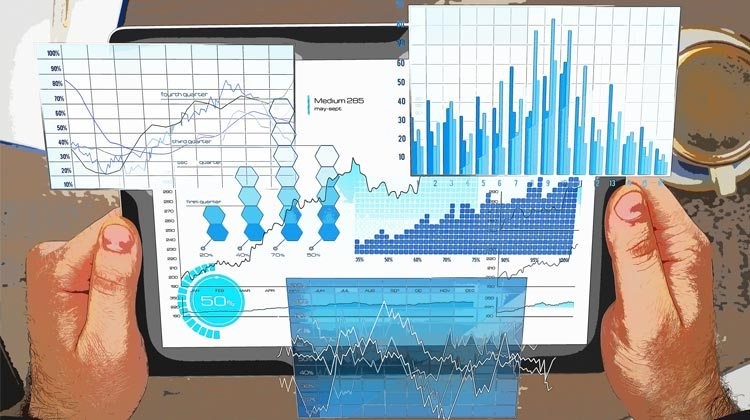by Ana Gotter • January 26, 2018
The Ultimate Guide to Facebook Analytics
Facebook acts as a central hub for many businesses who are utilizing multiple social media sites. It may even be the very first touchpoint for a lot of their new customers, introducing them to the brand either organically or through paid ads.
Facebook knows this and they want to keep things that way.
Because they want to provide immense value to marketers as well as users, they’ve long had incredible analytics platforms for both organic and paid content. These analytics can help businesses track how effective all their campaigns are, whether they’re paying for them or not and make more informed decisions moving forward.
Facebook analytics can tell us a lot. Sometimes, in fact, it feels like it can actually tell us too much, giving us so much data we go into information overload. So what really matters, and what doesn’t? How can marketers find the information they really need?
In this blog post, we’ll answer all those questions and more, showing you how to find and interpret the data from three different analytics platforms that you can all access for your Facebook Page.
Are All of Facebook’s Analytics in One Place?
Facebook’s total analytics are divided up into three different analytics platforms. These are:
- Facebook’s Page Insights—which shows you detailed metrics on your Page and content performance over time.
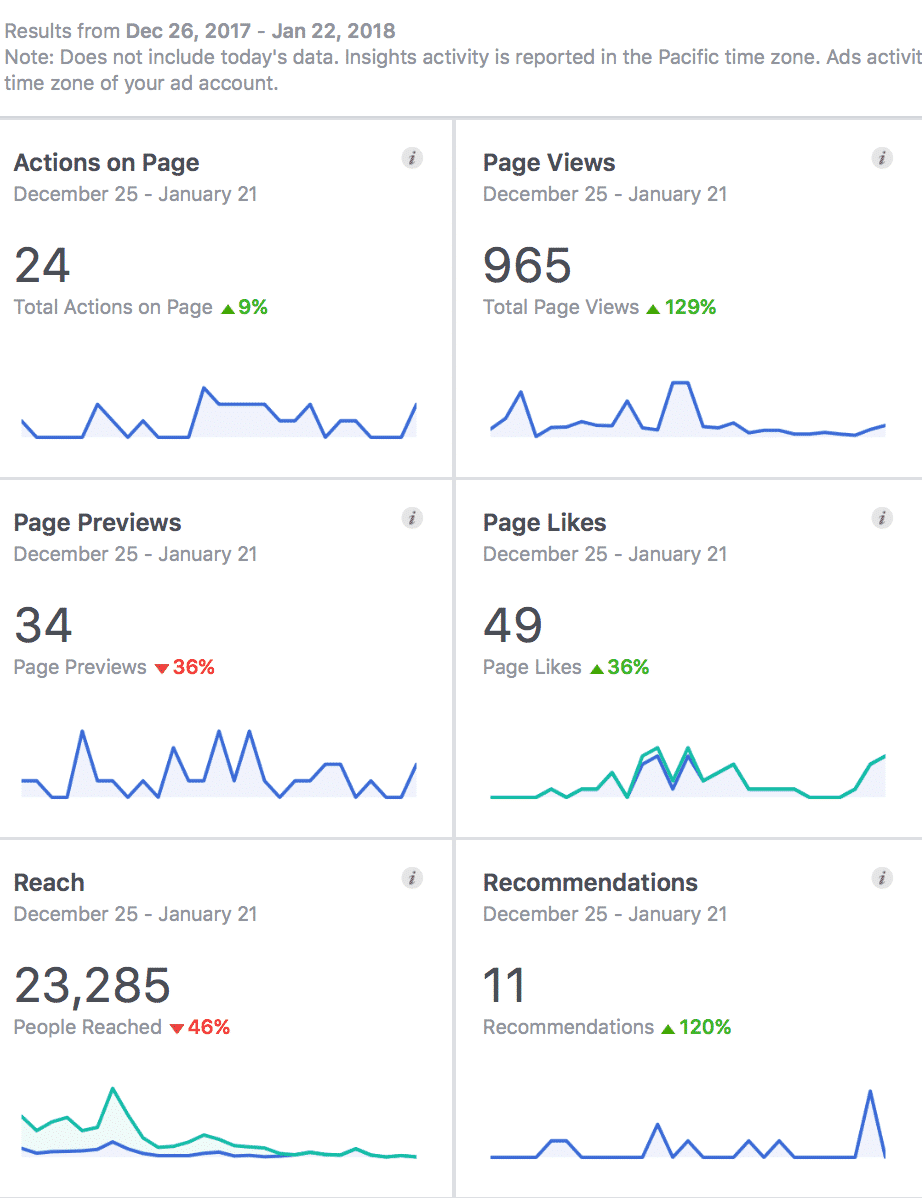
- Audience Insights—which can help you detect trends in your Page’s audience, who they are and see how it relates to other audiences on Facebook.
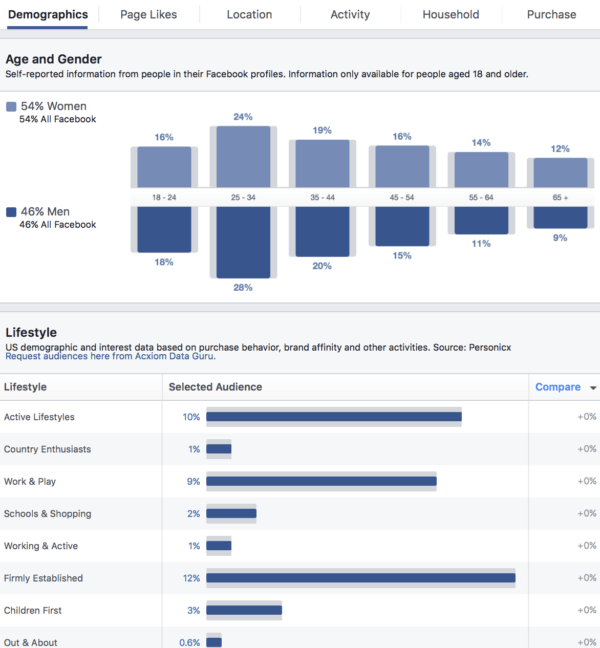
- Facebook’s Ads Manager—which provides you with detailed information about how your paid ads are performing on both Facebook and Instagram.

Each analytics platform is valuable in its own right and together, all three will give you the most complete picture of your marketing progress on Facebook, as long as you know which data to take in and which to ignore.
What Metrics Should I Monitor Most?
Each of Facebook’s analytics platforms gives you a lot of information. It can actually be so much information that it becomes overwhelming and if you’re unable to focus in on the metrics that matter, you’ll be a little lost trying to move forward.
You’ll notice that I said “the metrics that matter.” That statement directly implies that there are some metrics that just don’t matter and, in a way, that’s true.
There are metrics that we call “vanity metrics,” which are those that might look important but don’t actually reflect the status of your campaigns. The number of Page likes, for example, doesn’t matter quite as much as a Page’s engagement rate. A Facebook Page with 600 likes and a 15% engagement rate is in much better shape than one with 10k likes and a 2% engagement rate.
Let’s take a look at each individual Facebook analytics platform and which metrics matter most.
Facebook Page Insights
Facebook Page Insights provide data on everything happening on your brand’s Page. If you want to track your Page’s content, engagement and follower size, this is the place to look.
Facebook Page Insights gives you data like:
- A preview of all the metrics on your Page that happened within the last 30 days
- Follower count, and what devices people followed you on
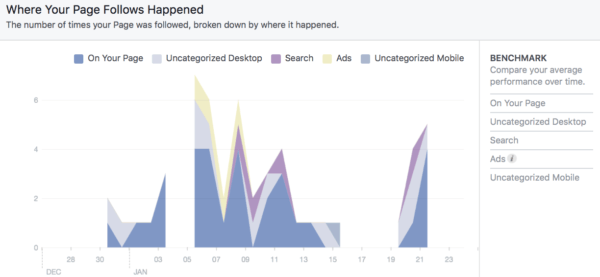
- Page likes, including growth trends over time
- The reach of your posts
- Engagement of your content (including negative engagement like hides or reports as spam)
- How many times other users recommended or mentioned your Page
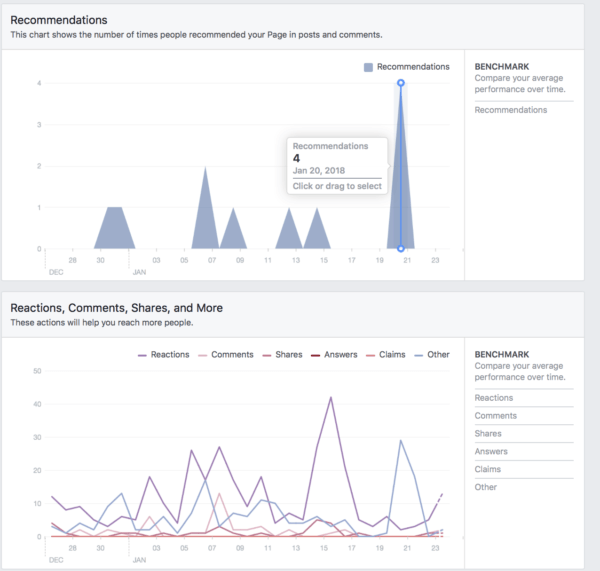
- Page views and page previews
- Actions on the Page, like those who messaged your or clicked on the “Call Now” CTA
- The exact engagement on all your posts, including number of clicks and both organic and paid comments, likes, and shares
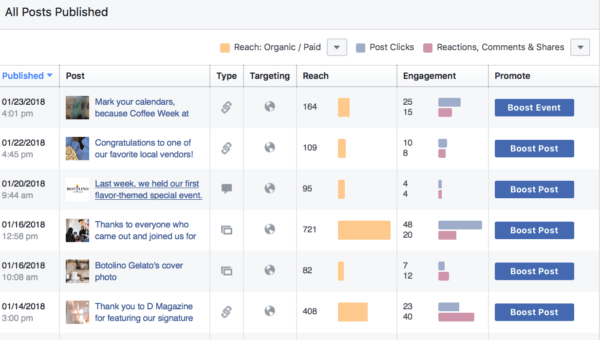
- Event response
- Video insights, including detailed metrics like how many minutes of each video were viewed and total number of views
- Information about who your audience is, and who you’re actually reaching with your posts
Page Insights: The Metrics That Matter Most
I wasn’t kidding. That’s a lot of information. But, some metrics will consistently matter more than others. Some might matter in certain circumstances, but not other’s. Here’s what I’d recommend paying the most attention to:
- Post engagement. What types of engagement are you getting? Even more importantly, which types of posts are getting you the most engagement?
- Engagement rates. More followers are great, but in reality, they’re only really valuable if they’re as engaged as the audience you already have. High engagement rates mean you have an enthusiastic audience, and that your content is hitting the sweet spot of what they’re looking for. You want to make sure that as your audience grows, your engagement rates stay up, too.
- Reach. Your reach will tell you how many people are seeing your content, which is a crucial metric to watch carefully. If you see it declining, it may be because there’s a new algorithm out, but either way, you need to look at what content helps you get better reach through engagement and Facebook’s own preferences. Native video, for example, will get significantly more reach than posts sharing outbound links. Look at both organic and paid reach, and if you think it’s a little too low, you can always boost important posts to get your numbers where you need them.
In general, you’ll also want to watch general trends with your follower count, but you don’t need to track it diligently. You should see a steady increase (barring big, sudden changes in the algorithm like what we’ve got now). If you see a drop off or no progress on a month-to-month basis, take a close look at your content’s engagement metrics and figure out why.
Facebook Ads Manager
Facebook Ads Manager is the reporting dashboard for all Facebook and Instagram ads that you run outside of in-app Instagram Promoted Posts. All of your ad campaigns can be viewed on this dashboard, even if they aren’t running yet or have been completed.
On this dashboard, you’ll be able to see the following metrics for each campaign:
- Results achieved, like event response, conversions, or leads generated
- Reach, which is the number of people who saw your ads
- Impressions, or the number of times your ads were seen; by whom isn’t taken into account
- Frequency, which tells you how many times your ad is seen, on average, by a single user
- Relevance score, which tells you how relevant Facebook believes your ad to be to your targeted audience; this is judged by their algorithms and engagement on your ad
- Clicks
- Cost per result
- Amount spent
Which Metrics Matter Most for Facebook Ads?
There’s also a lot more data there if you want to go digging and, unsurprisingly, it’s all a little overwhelming. The workaround to this, like with the organic metrics, is to avoid vanity metrics.
Here’s what you need to watch closely:
- Relevance score. Your relevance score will directly affect the cost and placements of your campaigns (as seen in the example below), so if your score isn’t a 6 or higher, it’s time for a revamp. I personally pause my campaigns if they aren’t a 7 or higher.
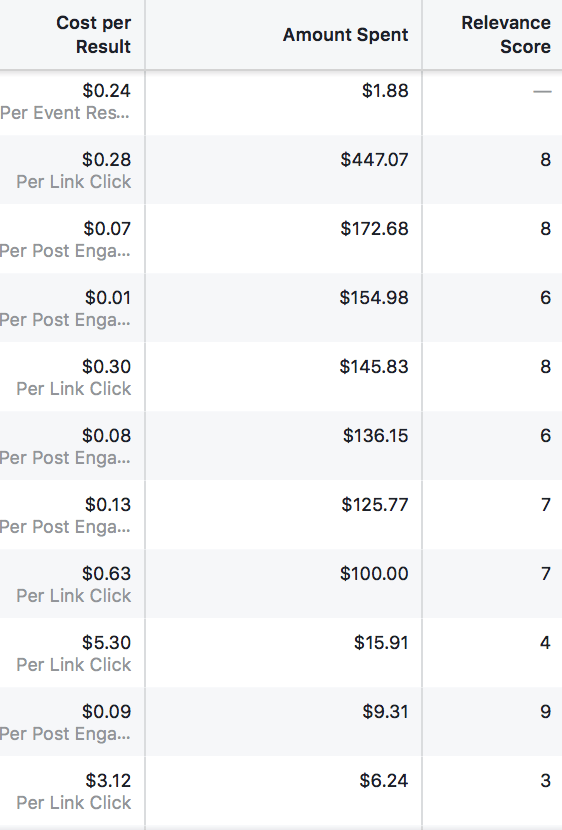
- Cost per result. Some people make the mistake of setting a budget and thinking that’s all that matters—that they won’t spend more than $300 or $3,000. That’s a quick way to get yourself in trouble. Instead, you need to make sure that each result is worth what you’re paying. You can spend $300 on fifty new customers, or on one—Facebook doesn’t care. It’s up to you to decide if the CPC is worth it. If not, you’re looking at a lot of wasted ad spend.
- Number of results you’re getting. If you’re running campaigns and putting a ton of time and energy into them and only getting a few results (even if they’re cost effective), you may want to consider switching platforms or trying new strategies.

- Frequency. This one doesn’t necessarily tell you a lot about how your ad is performing, but it can signal if your campaign is in good health. Sometimes people need to see your ad a few times before they decide to convert. If, however, your frequency creeps up higher than 3, it means that people have crossed the point of no return and are unlikely to convert on that offer. This can start to sink your relevance score over time. Watch it closely on active campaigns and if your frequency keeps getting too high too fast, consider expanding your audience.
Facebook Audience Insights
Audience Insights isn’t as prominently placed as the other Facebook analytic platforms. While you don’t need to monitor it diligently like the other two, it can still give you powerful information that you can use to your benefit.
Under the audience insights, you can see the breakdown among your audience of their:
- Location
- Age
- Gender
- Other Pages they like (and how relevant these Pages are to your business) and interests they are drawn to on Facebook.
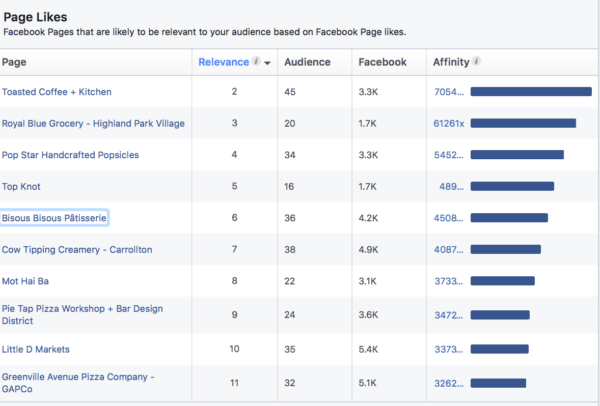
- How engaged your audience is overall on Facebook
- Household information like size, income and home ownership status
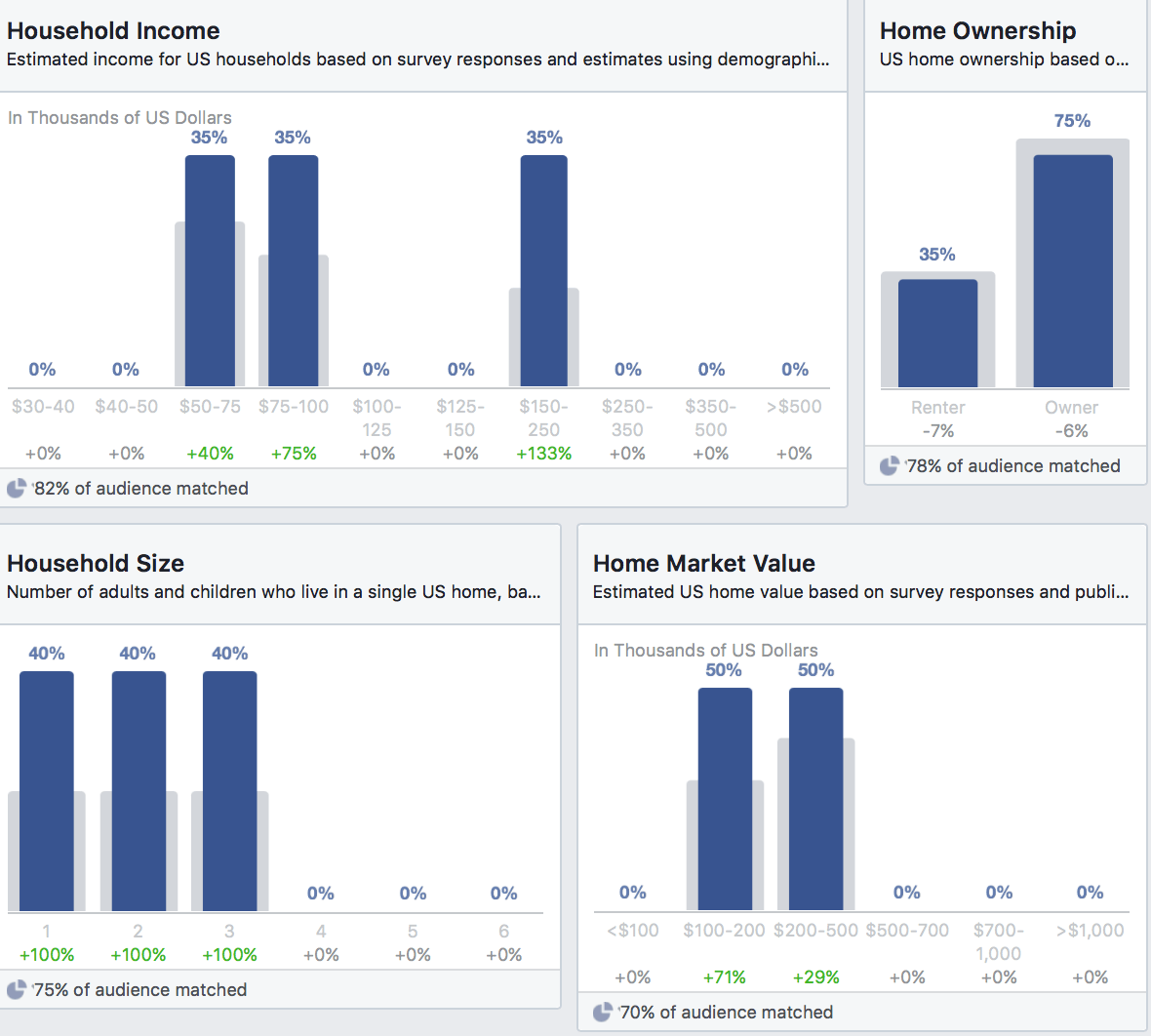
- Purchase behavior
- “Lifestyle types,” which are basically buyer personas created by Facebook.
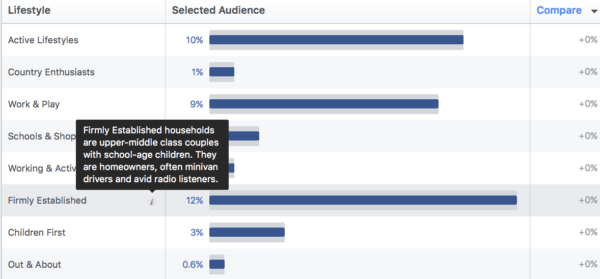
Unlike the other two sections here, we’re not going to focus on which metrics to look at, because this is data that’s meant to be useful, not data measuring progress. Instead, check in on this data every so often to see who your on-platform audience is.
Using this data, you can see if you’re missing any of your target audiences. You may also get new ideas for niche campaigns to run. One Page I managed for a restaurant had a number of followers who were interested in healthy eating and vegan eating, so we ran campaigns appealing directly to those individuals showcasing the restaurant’s vegan dishes to great success.
Conclusion
Analytics and close monitoring of your campaigns is important for all marketing efforts, and Facebook easily has the best native analytics platforms of all social media sites. Between their Page Insights, Audience Insights andAds Manager, you’ll be able to get the full picture of how your paid and organic campaigns are benefiting you as long as you focus in on the right metrics.
What do you think? Do you use native Facebook analytics platforms to help you track your marketing campaigns? Which metrics do you watch closely? Which do you ignore? Let us know what you think in the comments below!

